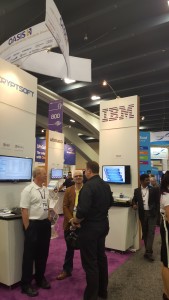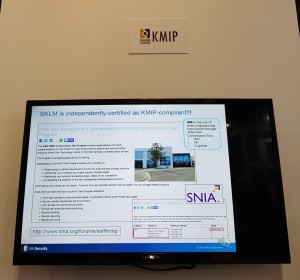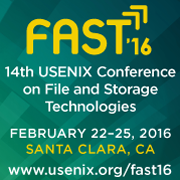The debate between hard drives and solid state drives goes on in 2016, particularly in the area of areal densities – the actual density of storage on a device. Fortunately for us, Tom Coughlin, SNIA Solid State Storage Initiative Education Chair, and a respected analyst who contributes to Forbes, has advised that flash memory areal densities have exceeded those of hard drives since last year!
Coughlin Associates provides several charts in the article which map lab demos and product HDD areal density since 2000, and contrasts that to new flash product announcements. Coughlin comments that “Flash memory areal density exceeding HDD areal density is important since it means that flash memory products with higher capacity can be built using the same surface area.”
Check out the entire article here.









 , and adoption of open standards for the global information society. The OASIS KMIP TC works to define a single, comprehensive protocol for communication between encryption systems and a broad range of new and legacy enterprise applications, including email, databases, and storage devices. The resulting Protocol, its profiles, and test cases are defined by the OASIS KMIP Technical Committee. By removing redundant, incompatible key management processes, KMIP provides better data security while at the same time reducing expenditures on multiple products.
Tony Cox, OASIS KMIP Technical Committee Co-Chair and Interoperability Event Lead, stressed that "The OASIS 2016 Interop is a small window into the reality of proven interoperability between enterprise key managers, HSMs, cryptographic devices, storage, security and cloud products. The interoperability demonstration helped to reinforce the reality of choice for CIOs, CSOs and CTOs, enabling products from multiple vendors to be deployed as a single enterprise security solution that addresses both current and future requirements."
Tony Cox is also the Chair of the
, and adoption of open standards for the global information society. The OASIS KMIP TC works to define a single, comprehensive protocol for communication between encryption systems and a broad range of new and legacy enterprise applications, including email, databases, and storage devices. The resulting Protocol, its profiles, and test cases are defined by the OASIS KMIP Technical Committee. By removing redundant, incompatible key management processes, KMIP provides better data security while at the same time reducing expenditures on multiple products.
Tony Cox, OASIS KMIP Technical Committee Co-Chair and Interoperability Event Lead, stressed that "The OASIS 2016 Interop is a small window into the reality of proven interoperability between enterprise key managers, HSMs, cryptographic devices, storage, security and cloud products. The interoperability demonstration helped to reinforce the reality of choice for CIOs, CSOs and CTOs, enabling products from multiple vendors to be deployed as a single enterprise security solution that addresses both current and future requirements."
Tony Cox is also the Chair of the  SNIA provides a KMIP Conformance Test Program that enables organizations with KMIP implementations in their products to test those products against test tools and other products at the SNIA Technology Center in Colorado Springs, Colorado. According to SNIA's KMIP Test Program Manager David Thiel, the KMIP Test Program provides independent verification from a trusted third party that a given KMIP implementation conforms to the KMIP standard. Verification gives confidence to both vendors and end users of KMIP solutions that a product will interoperate with other similarly tested KMIP products. KMIP support has become a prerequisite requirement for organizations looking to acquire storage and security key management solutions.
For vendors with a product that supports KMIP, having the product successfully complete SNIA's KMIP Conformance Test Program is the best way to instill customer confidence. Any organization with a KMIP implementation can test in the SNIA's vendor-neutral, non-competitive environment. For KMIP Server testing, the vendor places the Server in the SNIA Technology Center and trains the KMIP Test Program staff on its use. For KMIP Client testing, the vendor connects the Client over the Internet to the test apparatus at the SNIA Technology Center or installs the Client in the SNIA Technology Center. The KMIP Test Program staff then tests the Server or Client and reports results to the vendor. All information regarding vendor testing and test results is confidential until the vendor releases successful test results for publication.
To date, products from Cryptsoft, Hewlett Packard Enterprise, and IBM have successfully passed KMIP Conformance Tests. Test results can be found on the
SNIA provides a KMIP Conformance Test Program that enables organizations with KMIP implementations in their products to test those products against test tools and other products at the SNIA Technology Center in Colorado Springs, Colorado. According to SNIA's KMIP Test Program Manager David Thiel, the KMIP Test Program provides independent verification from a trusted third party that a given KMIP implementation conforms to the KMIP standard. Verification gives confidence to both vendors and end users of KMIP solutions that a product will interoperate with other similarly tested KMIP products. KMIP support has become a prerequisite requirement for organizations looking to acquire storage and security key management solutions.
For vendors with a product that supports KMIP, having the product successfully complete SNIA's KMIP Conformance Test Program is the best way to instill customer confidence. Any organization with a KMIP implementation can test in the SNIA's vendor-neutral, non-competitive environment. For KMIP Server testing, the vendor places the Server in the SNIA Technology Center and trains the KMIP Test Program staff on its use. For KMIP Client testing, the vendor connects the Client over the Internet to the test apparatus at the SNIA Technology Center or installs the Client in the SNIA Technology Center. The KMIP Test Program staff then tests the Server or Client and reports results to the vendor. All information regarding vendor testing and test results is confidential until the vendor releases successful test results for publication.
To date, products from Cryptsoft, Hewlett Packard Enterprise, and IBM have successfully passed KMIP Conformance Tests. Test results can be found on the  SNIA is pleased to announce the appointment of its new Executive Director, Michael Oros. A 20-year industry veteran, Michael comes to SNIA from Intel where he was instrumental in overseeing a wide range of strategic industry initiatives, and for the development and deployment of storage, backup, and disaster recovery services. He also led the formation of the Open Data Center Alliance and with the Board of Directors, established the organization’s presence and reach across six continents, with world leading members accelerating cloud adoption and transformation of the IT landscape.
David Dale, SNIA Chairman, recently sat down with Michael to discuss his vision for the future of SNIA.
Dale: Michael, welcome to SNIA. We’re excited to have you on board.
Oros: Thank you David. I am honored and thrilled to be here! These are exciting times for the storage industry, and I strongly believe SNIA and the member companies are poised to be at the center of this transformation.
Dale: How long have you been involved with SNIA?
Oros: I’ve been involved with SNIA indirectly since 2000, when fibre channel interoperability was an industry challenge that I had to address for Intel’s managed storage service offerings. Since 2004, I have participated more directly starting with my first SNW event in Phoenix.
Dale: What attracted you to the Executive Director position and what excites you the most about SNIA?
Oros: The opportunity to lead, facilitate and be part of the storage industry transformation. The great people that make up the storage industry – an amazing SNIA Board of Directors that’s passionate and cares deeply, great staff and incredible volunteers; these were key attributes that I personally value and sought out.
Dale: What are the major changes forthcoming in the storage industry that SNIA needs to be actively involved with?
Oros: The flurry of M&A activity over the past couple years has already changed the storage industry landscape, and we can expect to see over the next couple years the impact and innovation coming out from these mergers/acquisitions. SNIA needs to be nimble; continue to deliver value through standards and initiatives that are of high importance and relevancy to the storage industry and the implementers/consumers of enterprise storage technologies: enterprise IT, cloud service providers and hyperscalers.
Dale: What do you think the impact of the 3rd Platform will be to the industry?
Oros: Huge! The analyst terminology referring to the third computing platform that encompasses mobile, social, cloud computing, and Internet of Things, is driving an increase in both storage demand and efficiency. As billions of users/devices and millions of apps interact on this “3rd Platform”, IT organizations have to change how they do business and manage this exponential increase in assets, data they are generating and its security. The storage industry and vendors have to innovate and deliver solutions that are lower touch to deploy and manage, more flexible and adaptable to an array of applications and security requirements.
Dale: What do you see as SNIA’s top goals for 2016?
Oros: Continue to be relevant in our work to the industry and our member companies, execute on the technology specifications, and grow the organization.
Dale: One week in the role, what are your initial thoughts and plans?
Oros: First, a big thank you to everyone for their help and support as I’ve come on board! I’ve started working with the team to ensure the member companies have the best resources and tools available to collaborate on technology specifications and initiatives – myself and all SNIA staff are here to support our members and delight our wonderful industry volunteers. Business development and outreach will see an increase in activity. And marketing programs are being planned in addition to our events, to promote loudly and with clarity the vital work SNIA and member companies are doing!
To learn more, read the official
SNIA is pleased to announce the appointment of its new Executive Director, Michael Oros. A 20-year industry veteran, Michael comes to SNIA from Intel where he was instrumental in overseeing a wide range of strategic industry initiatives, and for the development and deployment of storage, backup, and disaster recovery services. He also led the formation of the Open Data Center Alliance and with the Board of Directors, established the organization’s presence and reach across six continents, with world leading members accelerating cloud adoption and transformation of the IT landscape.
David Dale, SNIA Chairman, recently sat down with Michael to discuss his vision for the future of SNIA.
Dale: Michael, welcome to SNIA. We’re excited to have you on board.
Oros: Thank you David. I am honored and thrilled to be here! These are exciting times for the storage industry, and I strongly believe SNIA and the member companies are poised to be at the center of this transformation.
Dale: How long have you been involved with SNIA?
Oros: I’ve been involved with SNIA indirectly since 2000, when fibre channel interoperability was an industry challenge that I had to address for Intel’s managed storage service offerings. Since 2004, I have participated more directly starting with my first SNW event in Phoenix.
Dale: What attracted you to the Executive Director position and what excites you the most about SNIA?
Oros: The opportunity to lead, facilitate and be part of the storage industry transformation. The great people that make up the storage industry – an amazing SNIA Board of Directors that’s passionate and cares deeply, great staff and incredible volunteers; these were key attributes that I personally value and sought out.
Dale: What are the major changes forthcoming in the storage industry that SNIA needs to be actively involved with?
Oros: The flurry of M&A activity over the past couple years has already changed the storage industry landscape, and we can expect to see over the next couple years the impact and innovation coming out from these mergers/acquisitions. SNIA needs to be nimble; continue to deliver value through standards and initiatives that are of high importance and relevancy to the storage industry and the implementers/consumers of enterprise storage technologies: enterprise IT, cloud service providers and hyperscalers.
Dale: What do you think the impact of the 3rd Platform will be to the industry?
Oros: Huge! The analyst terminology referring to the third computing platform that encompasses mobile, social, cloud computing, and Internet of Things, is driving an increase in both storage demand and efficiency. As billions of users/devices and millions of apps interact on this “3rd Platform”, IT organizations have to change how they do business and manage this exponential increase in assets, data they are generating and its security. The storage industry and vendors have to innovate and deliver solutions that are lower touch to deploy and manage, more flexible and adaptable to an array of applications and security requirements.
Dale: What do you see as SNIA’s top goals for 2016?
Oros: Continue to be relevant in our work to the industry and our member companies, execute on the technology specifications, and grow the organization.
Dale: One week in the role, what are your initial thoughts and plans?
Oros: First, a big thank you to everyone for their help and support as I’ve come on board! I’ve started working with the team to ensure the member companies have the best resources and tools available to collaborate on technology specifications and initiatives – myself and all SNIA staff are here to support our members and delight our wonderful industry volunteers. Business development and outreach will see an increase in activity. And marketing programs are being planned in addition to our events, to promote loudly and with clarity the vital work SNIA and member companies are doing!
To learn more, read the official  SNIA Tutorials are educational materials developed by vendors, training companies, analysts, consultants, and end-users in the storage and information technology industry. SNIA tutorials are presented and used throughout the world at SNIA events and international conferences.
Utilizing VDBench to Perform IDC AFA Testing will be presented by Michael Ault, Oracle Guru, IBM, Inc. This SNIA Tutorial provides procedures, scripts, and examples to perform the IDC test framework utilizing the free tool VDBench on AFAs to provide a common set of results for comparison of multiple AFAs suitability for cloud or other network based storage.
Practical Online Cache Analysis and Optimization will be presented by Carl Waldspurger, Research and Development, CloudPhysics, Inc., and Irfan Ahmad, CTO, CloudPhysics, Inc. After reviewing the history and evolution of MRC algorithms, this SNIA Tutorial examines new opportunities afforded by MRCs to capture valuable information about locality that can be leveraged to guide efficient cache sizing, allocation, and partitioning in order to support diverse goals such as improving performance, isolation, and quality of service.
SNIA Tutorials are educational materials developed by vendors, training companies, analysts, consultants, and end-users in the storage and information technology industry. SNIA tutorials are presented and used throughout the world at SNIA events and international conferences.
Utilizing VDBench to Perform IDC AFA Testing will be presented by Michael Ault, Oracle Guru, IBM, Inc. This SNIA Tutorial provides procedures, scripts, and examples to perform the IDC test framework utilizing the free tool VDBench on AFAs to provide a common set of results for comparison of multiple AFAs suitability for cloud or other network based storage.
Practical Online Cache Analysis and Optimization will be presented by Carl Waldspurger, Research and Development, CloudPhysics, Inc., and Irfan Ahmad, CTO, CloudPhysics, Inc. After reviewing the history and evolution of MRC algorithms, this SNIA Tutorial examines new opportunities afforded by MRCs to capture valuable information about locality that can be leveraged to guide efficient cache sizing, allocation, and partitioning in order to support diverse goals such as improving performance, isolation, and quality of service.
Leave a Reply